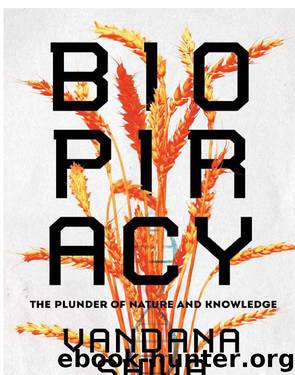Biopiracy by Vandana Shiva

Author:Vandana Shiva
Language: eng
Format: epub
Publisher: North Atlantic Books
Published: 2016-11-30T05:00:00+00:00
Biodiversity: Whose Resource?
Biodiversity has always been a local common resource. A resource is property when social systems exist to use it on the principles of justice and sustainability. This involves a combination of rights and responsibilities among users, a combination of utilization and conservation, a sense of coproduction with nature and of gift giving among members of the community.
There are many levels at which resource ownership and the concept of knowledge and access to it differs between private property regimes and common property systems. Common property systems recognize the intrinsic worth of biodiversity; regimes governed by IPRs see value as created through commercial exploitation. Common property knowledge and resource systems recognize creativity in nature. As John Todd, a visionary biologist, has stated, biodiversity carries the intelligence of three and a half billion years of experimentation by life-forms. Human production is viewed as coproduction and cocreativity with nature. IPR regimes, in contrast, are based on the denial of creativity in nature. Yet, they usurp the creativity of emerging indigenous knowledge and the intellectual commons. Further, since IPRs are more a protection of capital investment than a recognition of creativity per se, there is a tendency for ownership of knowledge, and the products and processes emerging from it, to move toward areas of capital concentration and away from poor people without capital. Knowledge and resources are, therefore, systematically alienated from the original custodians and donors, becoming the monopoly of the transnational corporations.
Through this trend, biodiversity is converted from a local commons into an enclosed private property. Indeed, the enclosure of the commons is the objective of IPRs in the areas of lifeforms and biodiversity. This enclosure is being universalized through the TRIPs treaty of the GATT and certain interpretations of the Biodiversity Convention. It is also the underlying mechanism of bioprospecting contracts.
Central to the privatization of knowledge and biodiversity is the devaluation of local knowledge, the displacement of local rights, and simultaneously, the creation of monopoly rights to biodiversity utilization through the claim of novelty. It has sometimes been argued that monopolies exist even in traditional communities. Yet, in the case of agriculture, for example, seeds and knowledge are freely exchanged as gifts. Similarly, knowledge of medicinal plants is a local common resource.
Plant-based systems of healing fall into two categories— folk systems and specialized systems, like Ayurveda, Siddha, and Unani. Even specialized systems, however, depend on folk knowledge. In the Ayurveda classic, Charaka Samhita, indigenous medical practitioners are advised:
Download
This site does not store any files on its server. We only index and link to content provided by other sites. Please contact the content providers to delete copyright contents if any and email us, we'll remove relevant links or contents immediately.
The Secret History by Donna Tartt(18951)
The Social Justice Warrior Handbook by Lisa De Pasquale(12170)
Thirteen Reasons Why by Jay Asher(8849)
This Is How You Lose Her by Junot Diaz(6837)
Weapons of Math Destruction by Cathy O'Neil(6220)
Zero to One by Peter Thiel(5736)
Beartown by Fredrik Backman(5682)
The Myth of the Strong Leader by Archie Brown(5463)
The Fire Next Time by James Baldwin(5386)
How Democracies Die by Steven Levitsky & Daniel Ziblatt(5175)
Promise Me, Dad by Joe Biden(5117)
Stone's Rules by Roger Stone(5053)
A Higher Loyalty: Truth, Lies, and Leadership by James Comey(4909)
100 Deadly Skills by Clint Emerson(4882)
Rise and Kill First by Ronen Bergman(4741)
Secrecy World by Jake Bernstein(4703)
The David Icke Guide to the Global Conspiracy (and how to end it) by David Icke(4658)
The Farm by Tom Rob Smith(4468)
The Doomsday Machine by Daniel Ellsberg(4452)
